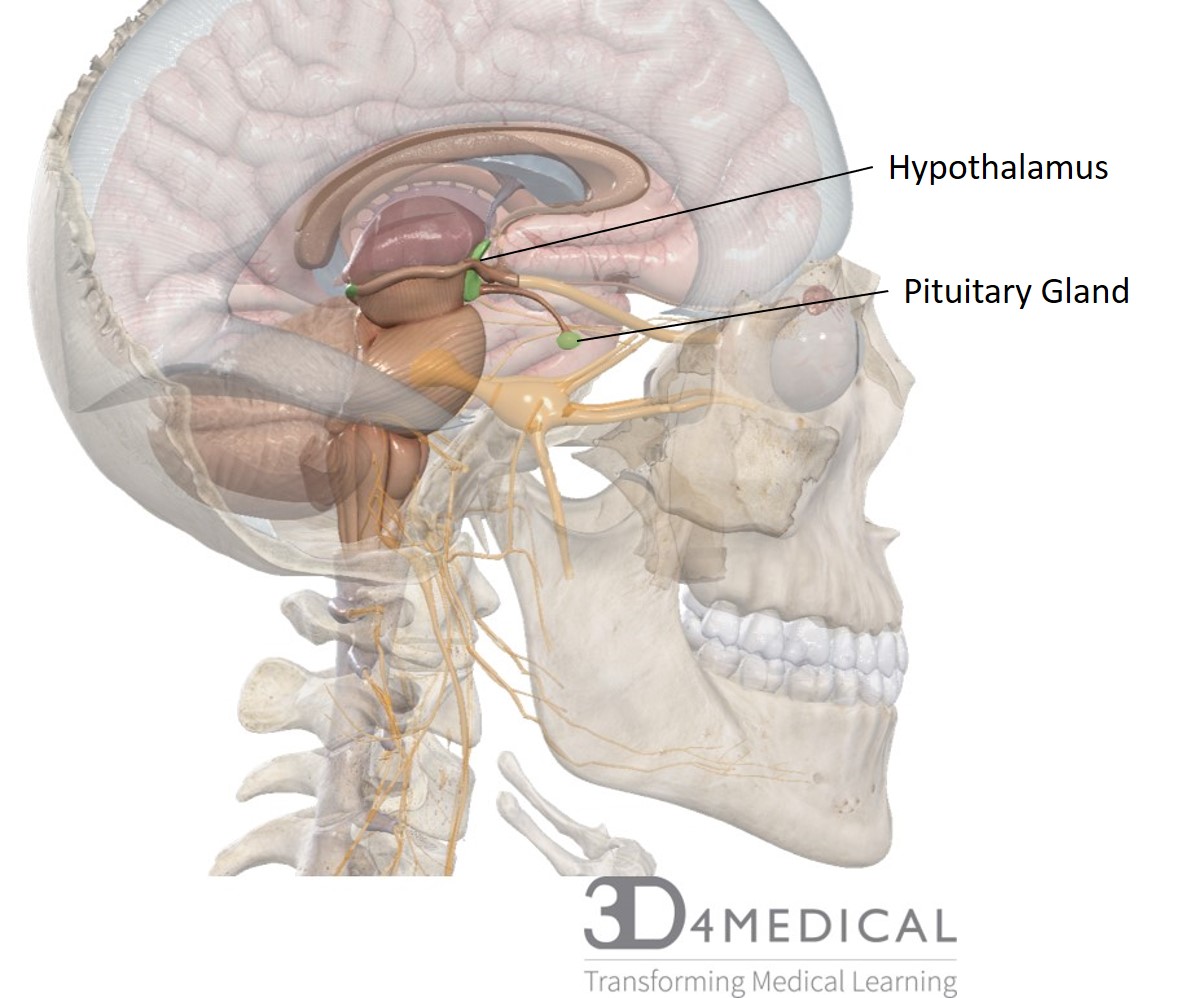The Head and Neck
Hypothalamus and Pituitary Glands
The Organ: Hypothalamus

The hypothalamus is a structure that is found in the diencephalon region of the brain. The hypothalamus is also included in the limbic system which also includes the thalamus, reticular formation, cingulate gyrus, parahippocampal gyrus, dentate gyrus, fornix, amygdaloid body, and hippocampus. The thalamus is the where most of the sensory signals are collected and distributed to other brain regions. The Hypothalamus fall directly below the thalamus. The main role of the hypothalamus is to integrate the center of the autonomic nervous system and regulates hormonal functions. Other functions that the hypothalamus is responsible are skeletal muscle contractions, autonomic functions, the secretion of two hormones, the production of emotions and behavioral drives, coordination of the voluntary and involuntary (autonomic) functions, regulation of the body temperature, and circadian rhythms. The endocrine function of the hypothalamus is closely tired with the pituitary gland, which is connected to the hypothalamus by the infundibulum which is a slender, funnel-shaped structure.
The Hypothalamic Hormones
The hypothalamus release two hormones as well as many hormones that regulate the pituitary hormones. The regulatory hormones are hormones that are released from the hypothalamus and regulate the release of pituitary hormones. These include Thyrotropin-releasing hormone (TRH), Corticotropin-releasing hormone (CRH), Gonadotropin-releasing hormone(GnRH), Prolactin-releasing factor (PRF), Growth hormone-releasing hormone (GH-RH), Melanocytes- stimulating hormone (MSH). See table under Pituitary Hormones to see the function of each hormone, their target organ, and the hypothalamic hormone that regulates them.
The other two hormones that are released by the hypothalamus are oxytocin and antidiuretic hormone. These hormones are passed down the axons of nerves that travel between the hypothalamus and the posterior lobe of the pituitary gland. From the pituitary, they are released into the bloodstream to their target organs.
The Organ: Pituitary gland
The pituitary gland sits caudal to the third ventricle of the brain and the hypothalamus. The small, oval gland sits in the Turkish saddle or Sella Turcica of the skull. Within the Sella Turcica, the pituitary gland is held in position by the Sellar Diaphragm. The Sellar Diaphragm is a Dural sheet that encircles the infundibulum, which is a funnel-shaped structure that connects the hypothalamus and the pituitary gland. The Sellar diaphragm’s function is to isolate the pituitary gland from the cranial cavity and lock it into position in the Sella Turcica.
The pituitary gland has two lobes the anterior and posterior lobe. The anterior lobe, or the adenohypophysis, has three regions: The pars distalis, the pars tuberalis, and the pars intermedia. Pars distalis is the largest and most anterior portion of the anterior lobe. The pars tuberalis is a portion that is adjacent the infundibulum. Lastly, the pars intermedia is a narrow portion the forms the border between the anterior and posterior lobes of the pituitary gland. The anterior lobe of the pituitary gland has an assortment of endocrine cells. The majority of the diversity can be found in the pars distalis, with the exception of the MSH which is secreted by the pars intermedia.
The posterior lobe is made up of mostly neural tissues and is part of the diencephalon. The Diencephalon contains the thalamus, hypothalamus, and the posterior pituitary. The posterior lobe, or the neurohypophysis, contains the axon terminals of the hypothalamic neurons. This thereby indicates that the cell bodies are located in the hypothalamus with the axons running down the infundibulum. The two hormones are the Antidiuretic hormone and Oxytocin, these are produced in the hypothalamus and follow the neuron down to the pituitary to be released via the posterior pituitary. Antidiuretic hormone is produced by the supraoptic nuclei and Oxytocin is produced by the paraventricular nuclei.
Every endocrine cell in the pituitary gland has immediate access to the bloodstream via the Hypophyseal portal system. The capillaries in this region of unusually permeable due to the nature of the endothelial cells. By having easy access to the bloodstream through permeable capillaries hormones secreted by the pituitary can be moved through the body to their target organs. The permeability is also impacted by having fenestrated capillaries, which means that the capillary allows larger molecules to enter and exit the bloodstream. The capillary network is feed by the superior and inferior hypophyseal artery. The anterior lobe of the pituitary gland is feed by the superior hypophyseal artery. The superior hypophyseal artery feeds the capillary network near the median eminence which is a swelling cranial to the infundibulum. The Inferior hypophyseal artery delivers the capillary bed that feeds the posterior lobe of the pituitary gland.
The Pituitary Hormones
| Hormone | Acronym | Where is it released from | Target Organs | Hormonal effect | Hypothalamic regulatory hormone Acronym |
| Anterior Pituitary | |||||
| Adrenocorticotropic Hormone | ACTH | Pars Distalis | Adrenal cortex | Stimulation the secretion of glucocorticoids (cortisol, corticosterone) | CRH |
| Follicle-stimulating hormone (female) | FSH | Pars Distalis | Follicle cells of ovaries | Secretion of estrogen, follicle development | GnRH |
| Follicle-stimulating hormone (male) | FSH | Pars Distalis | Nurse cells of the testes | Secretion of estrogen, follicle development | GnRH |
| Growth Hormone | GH | Pars Distalis | All cells | Growth, protein synthesis, | GH-IH
GH-RH |
| Luteinizing hormone (female) | LH | Pars Distalis | Follicle cells of ovaries | Stimulations Ovulation, the formation of the corpus luteum, and secretion of progesterone | GnRH |
| Luteinizing hormone (male) | LH | Pars Distalis | Interstitial cells of testes | Secretion testosterone | GnRH |
| Prolactin | Pars Distalis | Mammary glands | Production of milk | PRF
PIH |
|
| Thyroid-stimulating hormone | TSH | Pars Distalis | Thyroid gland | Stimulating the secretion of T4 and T3 | TRH |
| Melanocyte-stimulating Hormone | MSH | Pars Intermedia | Melanocytes in the skin | Increase melanin synthesis | MSH-IH |
| Posterior Pituitary | |||||
| Anti-diuretic hormone | ADH | supraoptic nuclei | Kidneys | Reabsorption of water, elevation of blood volume and pressure | none |
| Oxytocin (female) | paraventricular nuclei | Uterus and mammary gland | Stimulates labor contractions and milk ejection | none | |
| Oxytocin (male) | paraventricular nuclei | Ductus deferens and prostate gland | Contraction of the ductus deferens and prostate gland | none | |
Clinical applications
The hypothalamus and pituitary are so closely linked together that often it’s hard to determine which one is causing the symptoms. One difference that can indicate whether it is a problem with the hypothalamus or the pituitary, is how many systems are affected. With problems seen in the hypothalamus, often more systems are affected. With pituitary based problems symptoms are often associated with one of the hormones it is responsible for. The difference can be seen when you compare ROHHAD which is a problem with the hypothalamus and Acromegaly which is a problem with the pituitary gland.
When the hypothalamus is affected the symptoms can be diverse and severe. An example of this is ROHHAD or rapid-onset obesity with hypothalamic dysfunction, hypoventilation, and autonomic dysregulation. Since the hypothalamus is responsible for signaling many different hormone systems as well as autonomic systems the symptoms of ROHHAD are vast. Often diagnosed between the ages of 1.5 and 7 years of age, the first symptom is a rapid-0nset obesity which involves gaining 30 pounds in 6 to 12 months. This is a significant amount, especially for this age group. Other symptoms include the inability to maintain a normal water balance, hypothyroidism, early or late puberty, growth hormone deficiency, high prolactin levels, problems with regulating the Autonomic Nervous System, alveolar hypoventilation, behavioral problems and increased risk of certain types and tumors. As the autonomic nervous system has many responsibilities with the body, poor regulation of it can also cause inability to regulate body temperature, slow heartbeat, excessive sweating, altered pupil response to light, crossed eyes, and or intestinal abnormalities. Not all symptoms necessarily present themselves in each case of ROHHAD. Therefore treatment is often based on symptoms that show themselves.
When it comes to problems with the attributed with the pituitary, it can be hard to pinpoint whether or not it’s a problem with the hypothalamus not signaling effectively or the pituitary responding appropriately. An example of this is a problem that is associated with Acromegaly. Acromegaly is a form of gigantism where the pituitary releases an inappropriate amount of growth hormone, causing individuals to grow to be very tall and often continue to grow long past puberty when normal growth stops. There have been a few well know examples of Acromegaly like Morteza Mehrzad and Andre the Giant. Morteza Mehrzad is an Iranian Paralympic seated volleyball player, his height as of the 2016 Paralympic games is was 8 feet 1 inch. Acromegaly can cause symptoms like enlarged feet and hands and excessive height which For Mehrzad turn something that his community shunned him for into something that he is now famous for in the Paralympic sporting world. However, acromegaly often shortens the lifespan of individuals diagnosed with it. In the case of Andre the Giant, who was a well-known WWE wrestler for his acting role in the Princess Bride, died at the age of 46 due to heart failure. Heart failure is one of the possible ways Acromegaly can reduce lifespan. This is caused by the growth hormone affecting the heart to enlarge.
Andre the giant, Actor and pro-WWE Wrestler

Morteza Mehrzad, an Iranian Paralympic seated volleyball player
References
https://www.endocrineweb.com/endocrinology/overview-hypothalamus
https://www.endocrineweb.com/endocrinology/overview-pituitary-gland
http://www.wwe.com/superstars/andrethegiant
https://nypost.com/2018/04/09/the-triumph-and-tragedy-of-andre-the-gian
Bartholomew E.F., Hutching R.T. Martini F.H., Nath J.L, Ober C.E.,Ober W.O, O’Keefe R.A,& Welch K.. (2015) Fundamentals Of Anatomy and physiology (10th ed.) Pearson
Pictures
Andre the giant https://aloxecorton.wordpress.com/tag/alcoholism/
Morteza Mehrzad https://www.tasnimnews.com/en/news/2017/02/21/1335013/morteza-mehrzad-bosnia-seeks-revenge-against-iran-sitting-volleyball

